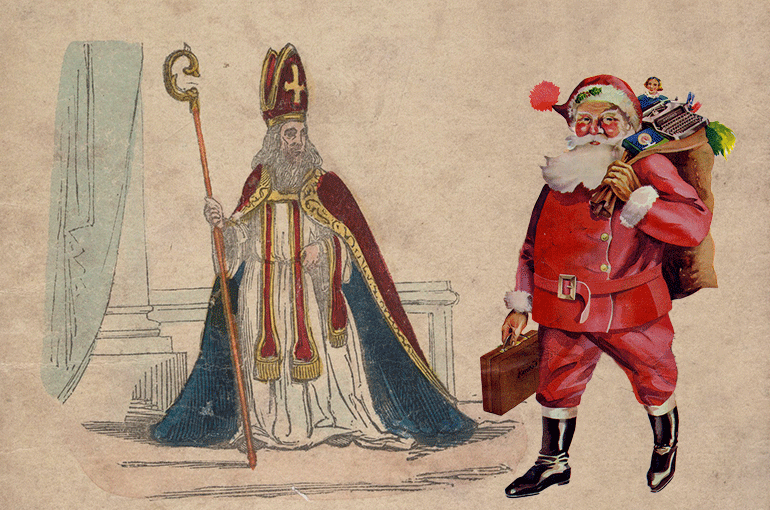Why is Santa Claus fat (while Sinterklaas isn’t)?

Santa Claus is jolly and bulky, while Sinterklaas is stately and slender. Why is that? And who is actually older, Sinterklaas or Santa Claus? Where do they come from? Are they brothers, or family at least? Basically, what exactly is the difference between Sinterklaas and Santa Claus? Historian of science Hieke Huistra has the answers.
December is all about gifts. People have been giving each other gifts in the last month of the year for many centuries – since long before we became acquainted with Santa Claus, before Sinterklaas existed, before Nicholas of Myra lived, and before we celebrated the birth of Jesus. In December celebrations, the gifts are a constant, but what has been constantly changing is the one who brings them. Each of the ‘gift givers’ taking a form that suited the time and place in which they ‘lived’.
Sinterklaas and Santa Claus: differences and similarities

Nowadays, we are most familiar with Sinterklaas, a traditional figure in the Netherlands, and Santa Claus or Father Christmas. They are a kind of brothers, or at least close relatives. Santa Claus is the American version of Sinterklaas, as is clearly revealed by his name: Santa Claus is a corruption of the Dutch Sint Nicolaas (Saint Nicholas) or Sinterklaas.
Besides the name, there are other similarities. Both are old, white men who distribute sacks of gifts in December, especially to children. There are also clear differences, however. Sinterklaas is mounted on a horse, whereas Santa Claus rides in a sledge; Sinterklaas has a robe and crosier, Santa Claus has a red and white coat and trousers with fur trimming; and Sinterklaas is tall and slender, while Santa Claus is short and chunky.
History of Sinterklaas: why he is thin

Let’s start with the figure of St Nicholas. Around the twelfth century, he came to be seen as the bringer of the December gifts, which had already been customary for centuries. This probably began with French nuns, who distributed gifts to poor children in his name. From there, the figure of St Nicholas spread through Western and Central Europe.
Even though being fat was no problem in the Middle Ages, it could even be a status symbol, this medieval Saint Nicholas was already tall and thin. Because the Christian church had different views. It saw being fat as a sign of sin, of gluttony and the inability to control oneself. Of course, a saint could certainly not have such qualities.
St Nicholas was a perfect saint: a strict Catholic, who only presented gifts to children who had been well-behaved and dutifully said their prayers. A figure like this, in the medieval Christian context, could never be fat.
Is Santa Claus Sinterklaas? Or is Sinterklaas Santa Claus?
St Nicholas then travelled with Dutch people across the ocean to New York – which was then still New Amsterdam – and thus took up residence in the United States. Later on, other immigrants here also needed someone to bring their December gifts, and so an American version of St Nicholas arose in the 19th century: Santa Claus.

Santa Claus took on a different character from St Nicholas. He was no longer a strict Christian saint, but a friendly figure, with no religious association, who brought gifts to everyone. Santa Claus also got a makeover. He may have remained an old man, but instead of him being tall and thin, he became short and fat. In nineteenth-century America, fat people were seen as healthy, prosperous, and important, and often as friendly as well. Exactly the traits that suited the new Santa Claus.
In the decades around 1900, the slimness ideal arose and it became important to be thin. Now, slim people were regarded as attractive and healthy. But Santa Claus remained fat – his appearance had standardised just in time. If this had happened a few decades later, he might have been leaner.
Ultimately, we might still head in this direction nevertheless. A few years ago, Australian doctors wrote a half-serious, half-satirical article, stating that a fat Santa Claus set a bad example for children. Who knows, maybe it’s a first sign that Santa’s belly is slowly getting ready to shrink back to the size of Sinterklaas’s.
Hieke Huistra
Dr Hieke Huistra is a historian of science at Utrecht University’s Faculty of Science. In 2018, she discussed the history of international December celebrations at the Descartes Centre Christmas Colloquium. This article is based on that lecture.

